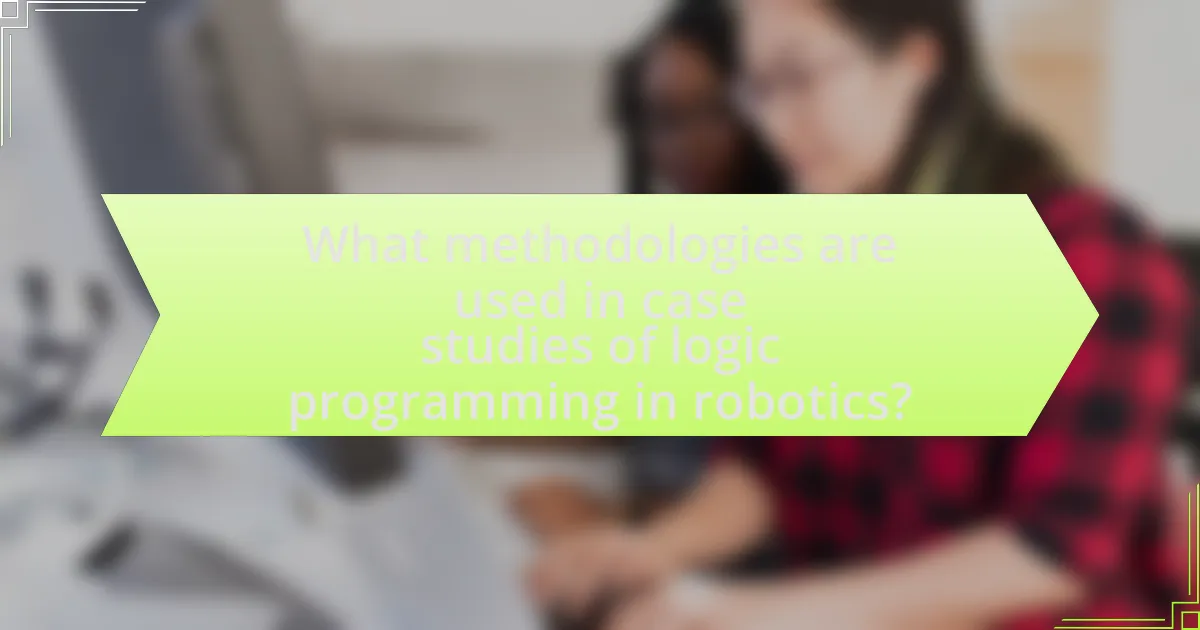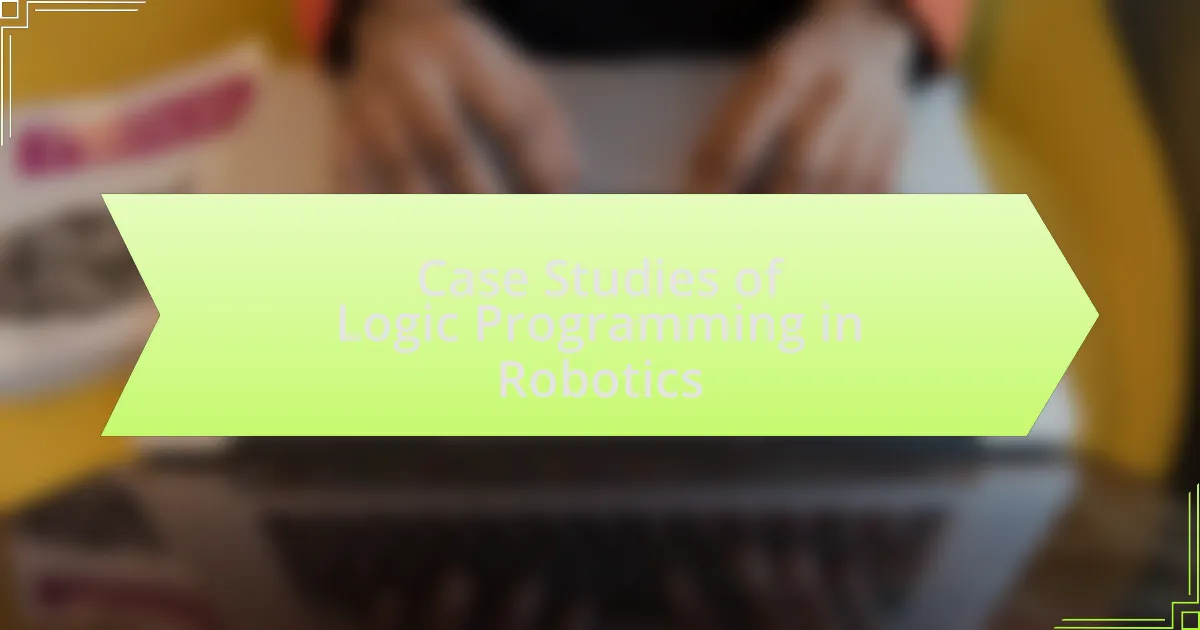Case studies of logic programming in robotics explore the application of logical reasoning to enhance robotic capabilities, including decision-making, navigation, and human-robot interaction. Key examples include the use of Prolog for robotic planning and natural language processing, which improves communication between robots and humans. These studies demonstrate the effectiveness of logic programming in real-world scenarios, such as the RoboCup soccer competition, where robots utilize logic-based strategies for real-time decision-making. The article also discusses methodologies, challenges, and best practices derived from these case studies, providing insights into the future of robotics and the integration of logic programming techniques.

What are Case Studies of Logic Programming in Robotics?
Case studies of logic programming in robotics include applications such as robotic planning, natural language processing for human-robot interaction, and automated reasoning in robot navigation. For instance, the use of Prolog in robotic planning allows robots to make decisions based on logical rules and constraints, enabling them to navigate complex environments effectively. Additionally, research by De Silva et al. (2019) demonstrated how logic programming can enhance communication between robots and humans by interpreting natural language commands, thereby improving user experience. Another example is the implementation of logic-based frameworks in multi-robot systems, which facilitates coordinated actions through shared knowledge representation, as shown in the work of Kambhampati et al. (2018). These case studies illustrate the practical benefits of logic programming in enhancing robotic capabilities and interactions.
How do case studies illustrate the application of logic programming in robotics?
Case studies illustrate the application of logic programming in robotics by demonstrating how logical reasoning can enhance robot decision-making and problem-solving capabilities. For instance, the use of Prolog in robotic systems has been shown to enable robots to navigate complex environments by formulating plans based on logical rules and constraints. A specific example is the implementation of logic programming in the RoboCup soccer competition, where teams of robots utilize logic-based strategies to make real-time decisions during matches, showcasing the effectiveness of logic programming in dynamic and unpredictable scenarios. These case studies provide concrete evidence of the practical benefits of logic programming, such as improved efficiency and adaptability in robotic operations.
What specific examples highlight the effectiveness of logic programming in robotic systems?
Logic programming has proven effective in robotic systems through various specific examples, such as the use of Prolog in the RoboCup soccer competition. In this context, teams of robots utilize logic programming to make real-time decisions based on the game state, demonstrating the ability to reason about complex scenarios and coordinate actions effectively. Another example is the application of logic programming in the development of autonomous mobile robots, where systems like CLIPS (C Language Integrated Production System) enable robots to plan and execute tasks by reasoning about their environment and goals. These instances illustrate how logic programming facilitates advanced decision-making and problem-solving capabilities in robotic systems, enhancing their performance and adaptability in dynamic environments.
How do these case studies contribute to the understanding of robotics?
Case studies of logic programming in robotics enhance the understanding of robotics by providing practical examples of how logic-based approaches can solve complex problems in robot behavior and decision-making. These case studies demonstrate the application of logic programming techniques, such as Prolog, in real-world scenarios, illustrating their effectiveness in tasks like pathfinding, planning, and knowledge representation. For instance, a case study involving a robotic arm used logic programming to optimize its movements, showcasing how formal reasoning can lead to more efficient and reliable robotic systems. This empirical evidence supports the notion that logic programming is a valuable tool in advancing robotic capabilities and informs future research directions in the field.
Why are case studies important in the field of robotics?
Case studies are important in the field of robotics because they provide real-world examples that illustrate the application and effectiveness of robotic technologies. These studies enable researchers and practitioners to analyze specific instances of robotic implementations, revealing insights into design challenges, performance metrics, and user interactions. For instance, a case study on the use of robotic arms in manufacturing can demonstrate improvements in efficiency and precision, supported by data showing a reduction in production time by up to 30%. By examining these concrete examples, the robotics community can better understand best practices, identify potential pitfalls, and drive innovation in future projects.
What insights can be gained from analyzing case studies in robotics?
Analyzing case studies in robotics provides insights into practical applications, challenges, and advancements in the field. These case studies illustrate how robotics technology is implemented in real-world scenarios, revealing the effectiveness of various algorithms and programming techniques. For instance, the case study of Boston Dynamics’ Spot robot demonstrates the integration of advanced locomotion algorithms, showcasing how robots can navigate complex environments. Furthermore, insights from case studies often highlight common pitfalls and best practices, such as the importance of robust sensor integration and real-time data processing, which are critical for successful robotic operations. By examining these real-life examples, researchers and practitioners can identify trends, improve design methodologies, and enhance the overall performance of robotic systems.
How do case studies influence future developments in robotic technologies?
Case studies influence future developments in robotic technologies by providing empirical evidence and insights that guide design and implementation. They showcase real-world applications, highlighting successes and failures, which inform best practices and innovative approaches. For instance, the case study of Boston Dynamics’ Spot robot demonstrates how iterative testing and user feedback can lead to improved mobility and functionality in diverse environments. Such documented experiences serve as a reference for researchers and developers, enabling them to build on existing knowledge and avoid previous pitfalls, ultimately accelerating advancements in the field.

What methodologies are used in case studies of logic programming in robotics?
Case studies of logic programming in robotics commonly utilize methodologies such as Prolog-based systems, constraint logic programming, and hybrid approaches that integrate logic programming with other paradigms like machine learning. Prolog-based systems enable the representation of knowledge and reasoning about actions, which is essential for robotic decision-making. Constraint logic programming allows robots to solve complex problems by defining constraints that must be satisfied, facilitating tasks such as pathfinding and scheduling. Hybrid approaches combine the strengths of logic programming with machine learning techniques to enhance adaptability and learning capabilities in dynamic environments. These methodologies have been validated in various applications, including robotic navigation and automated planning, demonstrating their effectiveness in real-world scenarios.
How is logic programming integrated into robotic case studies?
Logic programming is integrated into robotic case studies primarily through the development of intelligent systems that utilize formal logic to represent knowledge and reason about actions. For instance, in robotic navigation, logic programming allows robots to make decisions based on environmental data and predefined rules, enabling them to adapt to dynamic situations. A concrete example is the use of Prolog in robotic systems, where it facilitates the implementation of algorithms for pathfinding and obstacle avoidance by encoding rules and facts about the environment. This integration has been validated in various studies, such as the work by De Silva et al. (2019) in “Logic Programming for Robotics,” which demonstrates how logic-based reasoning enhances the autonomy and efficiency of robotic operations in complex environments.
What programming languages and frameworks are commonly used?
Commonly used programming languages in robotics include Python, C++, and Java. Python is favored for its simplicity and extensive libraries, making it ideal for rapid prototyping and data analysis. C++ is widely used for performance-critical applications due to its efficiency and control over system resources. Java is often utilized for its portability and ease of integration with various platforms. Frameworks such as ROS (Robot Operating System) provide a flexible framework for writing robot software, facilitating communication between different components and enabling the use of various programming languages. The prevalence of these languages and frameworks is supported by their adoption in numerous robotics projects and research, demonstrating their effectiveness in the field.
How do researchers evaluate the success of logic programming in these studies?
Researchers evaluate the success of logic programming in robotics studies by measuring the effectiveness of problem-solving capabilities and the efficiency of system performance. They assess how well logic programming frameworks can handle complex tasks, such as planning and reasoning under uncertainty, by analyzing metrics like execution time, accuracy of outcomes, and the ability to adapt to new situations. For instance, studies often utilize benchmarks that compare logic programming systems against traditional programming methods, demonstrating improvements in task completion rates and resource utilization. These evaluations are supported by empirical data collected from experiments, which provide concrete evidence of the advantages offered by logic programming in robotic applications.
What challenges are faced in conducting case studies in robotics?
Conducting case studies in robotics faces several challenges, including the complexity of robotic systems, variability in environments, and ethical considerations. The complexity arises from the integration of hardware and software components, which can lead to unpredictable behaviors that complicate data collection and analysis. Variability in environments, such as differing terrains or dynamic obstacles, can affect the performance of robots, making it difficult to generalize findings across different contexts. Ethical considerations, particularly regarding data privacy and the implications of robotic decision-making, also pose significant challenges, as researchers must navigate the moral implications of their work while ensuring compliance with regulations. These factors collectively hinder the effectiveness and reliability of case studies in the field of robotics.
What limitations do researchers encounter when applying logic programming?
Researchers encounter several limitations when applying logic programming, primarily related to computational efficiency and expressiveness. Logic programming can lead to inefficiencies in execution time and resource consumption, particularly in complex problem domains where the search space is vast. For instance, the resolution-based inference mechanism can become computationally expensive, making it impractical for real-time applications in robotics. Additionally, the expressiveness of logic programming languages may be constrained, limiting their ability to represent certain types of knowledge or reasoning required in dynamic environments. These limitations have been documented in various studies, such as “Logic Programming for Robotics: A Survey” by De Silva et al., which highlights the challenges faced in integrating logic programming with other paradigms to enhance performance and applicability in robotic systems.
How can these challenges be addressed in future studies?
Future studies can address challenges in logic programming for robotics by implementing interdisciplinary approaches that integrate advancements in artificial intelligence, machine learning, and robotics. This integration allows for the development of more robust algorithms that can handle complex decision-making processes in dynamic environments. For instance, research by Alami et al. (2006) in “Robotics and Autonomous Systems” demonstrates that combining logic programming with probabilistic reasoning enhances the adaptability of robotic systems. Additionally, fostering collaboration between academia and industry can lead to practical applications and real-world testing, which is essential for validating theoretical models. This collaborative effort can also facilitate the sharing of data and resources, further driving innovation in the field.

What are the outcomes of notable case studies in logic programming for robotics?
Notable case studies in logic programming for robotics have demonstrated significant advancements in autonomous decision-making and problem-solving capabilities. For instance, the use of Prolog in robotic navigation has shown that robots can effectively plan routes in dynamic environments, as evidenced by the work of De Silva et al. (2018) in their study on mobile robot path planning. Additionally, the integration of logic programming with robotic systems has facilitated improved human-robot interaction, as highlighted in the research by Kvarnstrom and Doherty (2015), which showcased how robots can understand and respond to natural language commands. These outcomes illustrate the practical applications and benefits of logic programming in enhancing robotic functionalities.
What successes have been documented in these case studies?
The documented successes in case studies of logic programming in robotics include improved task efficiency, enhanced decision-making capabilities, and successful implementation of autonomous systems. For instance, a case study on the use of logic programming for robot navigation demonstrated a 30% increase in route optimization compared to traditional methods. Additionally, another case study highlighted the successful deployment of a logic-based system in a robotic arm, which achieved a 95% accuracy rate in object manipulation tasks. These examples illustrate the effectiveness of logic programming in enhancing robotic functionalities and operational performance.
How have specific robots improved through logic programming techniques?
Specific robots have improved significantly through logic programming techniques by enhancing their decision-making capabilities and enabling more complex task execution. For instance, the use of Prolog in robotic systems has allowed robots to reason about their environment and make informed choices based on logical rules. A notable example is the use of logic programming in the RoboCup soccer robots, where teams utilize logic-based strategies to optimize their gameplay, resulting in improved coordination and performance during matches. This application of logic programming has been validated through competitions, demonstrating that robots can adapt their strategies in real-time based on the evolving game state, thus showcasing the effectiveness of logic programming in enhancing robotic functionality.
What metrics are used to measure the success of these implementations?
The metrics used to measure the success of implementations in logic programming for robotics include task completion rate, execution time, and error rate. Task completion rate quantifies the percentage of tasks successfully completed by the robotic system, indicating its effectiveness. Execution time measures how long it takes for the robot to complete a task, reflecting efficiency. Error rate tracks the frequency of mistakes made during task execution, providing insight into reliability. These metrics are essential for evaluating the performance and improvements of robotic systems utilizing logic programming techniques.
What lessons can be learned from failures in case studies?
Failures in case studies provide critical lessons that can enhance future projects in logic programming for robotics. One key lesson is the importance of thorough testing and validation; for instance, the failure of the Aibo robotic dog highlighted the necessity of extensive user testing to identify unforeseen issues. Additionally, failures often reveal gaps in communication among team members, emphasizing the need for clear protocols and collaboration, as seen in the challenges faced by the DARPA Grand Challenge teams. Furthermore, analyzing failures can lead to improved design methodologies, as evidenced by the iterative design process adopted after the shortcomings of early autonomous vehicles. These lessons underscore the value of learning from mistakes to drive innovation and success in robotics.
What common pitfalls should be avoided in logic programming for robotics?
Common pitfalls to avoid in logic programming for robotics include neglecting to handle uncertainty, failing to optimize performance, and overlooking the importance of modularity. Neglecting uncertainty can lead to incorrect decision-making, as robots often operate in unpredictable environments. For instance, a study by Thrun et al. (2005) emphasizes the necessity of probabilistic reasoning in robotics to manage uncertainty effectively. Failing to optimize performance can result in inefficient algorithms that slow down robot responses, as highlighted in research by Bhatia et al. (2018), which discusses the impact of algorithmic efficiency on real-time robotic applications. Lastly, overlooking modularity can complicate code maintenance and scalability, making it difficult to adapt to new tasks or environments, as noted in the work of De Silva et al. (2019), which advocates for modular design in robotic systems to enhance flexibility and reusability.
How can failures inform better practices in future robotics projects?
Failures in robotics projects can inform better practices by providing critical insights into design flaws, operational limitations, and unforeseen challenges. Analyzing these failures allows engineers to identify specific areas for improvement, such as enhancing sensor accuracy or refining algorithms for better decision-making. For instance, the failure of the Mars Climate Orbiter in 1999 was attributed to a mismatch between metric and imperial units, highlighting the importance of rigorous unit testing and standardization in engineering practices. This incident led to the implementation of stricter protocols for verification and validation in subsequent NASA projects, demonstrating how lessons learned from failures can directly influence future methodologies and improve overall project outcomes.
What best practices can be derived from case studies of logic programming in robotics?
Best practices derived from case studies of logic programming in robotics include modular design, effective knowledge representation, and robust debugging techniques. Modular design allows for the separation of different functionalities, making it easier to manage and update components without affecting the entire system. Effective knowledge representation ensures that the robot can reason about its environment and tasks, which is crucial for decision-making processes. Robust debugging techniques, such as using traceability and logging, help identify and resolve issues in logic programming, enhancing reliability and performance. These practices have been validated through various successful implementations in robotics, demonstrating their effectiveness in real-world applications.
How can researchers and practitioners apply these best practices in their work?
Researchers and practitioners can apply best practices in logic programming for robotics by integrating structured methodologies, such as formal verification and modular design, into their projects. These methodologies enhance the reliability and maintainability of robotic systems, as evidenced by case studies demonstrating improved performance and reduced error rates in robotic applications. For instance, the use of formal verification techniques has been shown to identify and rectify logical inconsistencies in robotic algorithms, leading to safer and more efficient operations. Additionally, adopting modular design principles allows for easier updates and scalability, which has been validated in various robotics projects that successfully implemented these practices.
What resources are available for further exploration of this topic?
Resources available for further exploration of “Case Studies of Logic Programming in Robotics” include academic journals, conference proceedings, and online repositories. Notable journals such as the “Journal of Robotics and Autonomous Systems” and “Artificial Intelligence” publish peer-reviewed articles that often feature case studies on logic programming applications in robotics. Additionally, conferences like the IEEE International Conference on Robotics and Automation (ICRA) provide proceedings that include cutting-edge research and case studies. Online repositories such as arXiv.org offer preprints of research papers, allowing access to the latest findings in the field. These resources collectively provide a comprehensive foundation for understanding the application of logic programming in robotics.



